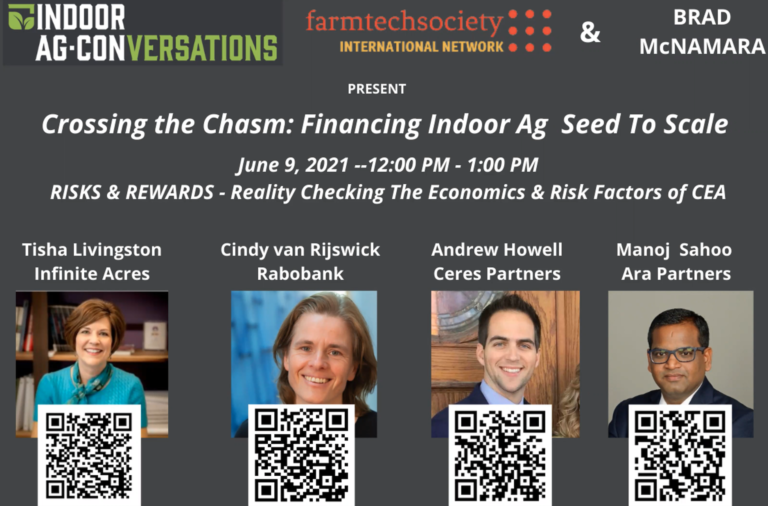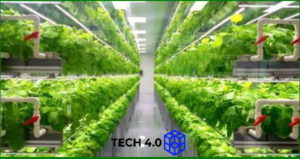“No matter how much technology you put in there, a lettuce is still a lettuce”
On June 9th 2021, FarmTech Society presented its first US webinar, “Crossing the Chasm: Financing Indoor Ag From Seed to Scale,” in partnership with Indoor Ag-Con. The agenda for Day One was hosted by Brad McNamara, while on Day Two FTS presented three panels, with distinct speakers invited and moderated by Tisha Livingston and Ian Kanski.
The three panels (one-hour duration each) focused on the realities of profitability and scale in different CEA operations, as well as the trends and innovations in finance and investment for the controlled-environment agriculture (CEA) sector. This event is definitely for an audience that is interested in the emerging opportunities and up to date funding strategies for emerging companies or commercial projects.
- Risks and Rewards—Reality Checking the Economics and Risk Factors of CEA
- Growing Up—Moving Beyond High Risk, High Cost Investment Capital
- CEA As Green Infrastructure—Positioning For Scale As Environmental and Social Impact Factors Become Essential to Investor Decisions
Here are the take home messages and a short review:

Panel 1
Starting a CEA facility is a challenging process that forces you to integrate uncertainty from the outset. Whether it be with regards to best-practice standards, sharing datasets for benchmarking, attracting investors or joining local food distribution and supply chains, CEA’s innovation realm and the subsequent invisibility creates daunting decisions sooner or later. Data is crucially needed but lacking.
Manoj Sahoo emphasized CEA’s need to differentiate itself from conventional agriculture, and other agro-ecological practices. For this is what will inform customers to recognize its benefits. “It’s like talking to your grandma,” he claims, when you must show the product’s added value. Manoj thinks that health-centered arguments are the most convincing ones for consumers increasingly looking into strengthening their health.
Another argument that CEA growers should put forward, according to the panelists, is the transparency of the food produced. Hygiene- and sanitary concerns have gained even more importance because of the Covid Pandemic.

Panel 2
The second panel started off by emphasizing that, with CEA, technology and innovation are finally permeating into the wider agriculture practice—an industry that is really sluggish in adopting innovations.
This creates a promising opportunity for renewed interest in agriculture from various sectors. While investing in tech venture capital is not a balance-sheet practice, investing in CEA operations does, because they bring in cash flows, predictability and carbon reduction along with new career options. This will attract greater attention from the tech industry, and so low risk investment opportunities.
It might, however, still be confusing to compare wide ranges of systems and technologies available and then select one. Remember that, at the end of the day, “no matter how much technology you put in there, a lettuce is still a lettuce” (David Chen, Equilibrium). The focus for the growers should be on the unit economics of CEA.

Panel 3
The last panel delved into how CEA can frame itself as an integral part for green infrastructure, with clear labor, social and environmental benefits, in a way that can improve and affect investors’ decisions. Notably, the relationship between CEA and renewable energies was explored as a promising synergy.
Georg Czerny (BayWa) mentioned how CEA can work as a buffer for local renewable energy grids, since the lighting time for crops can be scheduled in a way that alleviates the intensity of energy production from the grid. Whether crops received are lit up at night or during the day which will have no impact on the plants as long they receive the optimal amount of light in a 24 hrs period. .
To illustrate this point, Ian Kanski (Chairman of FarmTech Society) presented a pilot project in South-Eastearn Germany, named “Initiative Green Deal Lausitz”. The region is reeling from a dramatic transitioning from coal power to renewable energy, previously exclusively relying on the former. In collaboration with Fraunhofer University, FTS is convening its membership on the development of a renewable energy park integrated in a CEA cluster of 1,000 hectare. This project will boost regional food security, decarbonize the energy sector, as well as create 10,000 new career opportunities for jobs, while aiming for a carbon-free footprint in food production of plant and protein products.
Watch Replay of Day 2
(fill out the zoom form to get access to the video)



